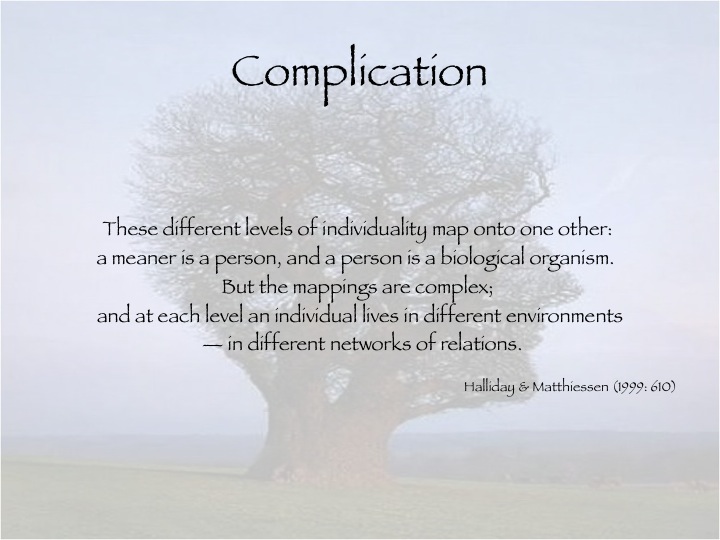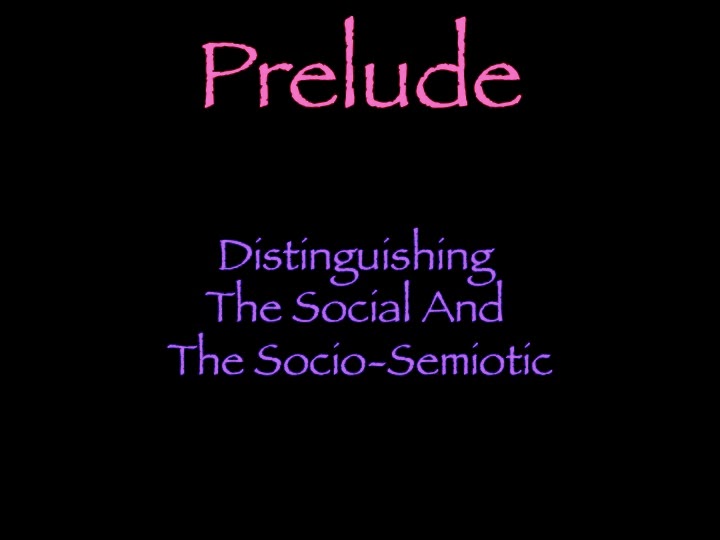…Our Threefold Order…
Construing Human Individuality Through Metalanguage
Wednesday, 28 August 2013
Tuesday, 27 August 2013
Slide 4: Orientation
OK, let’s begin by orienting you to this narrative with the following quote from Halliday & Matthiessen (1999: 610):
The human individual is at once a biological “individual”, a social “individual”, and a socio–semiotic “individual”:as a biological “individual”, s/he is an organism, born into a biological population as a member of the human species.
as a social “individual”, s/he is a person, born into a social group as a member of society. “Person” is a complex construct; it can be characterised as a constellation of social rôles or personæ entering into social networks…
as a socio–semiotic “individual”, s/he is a meaner, born into a meaning group as a member of a speech community. Meaner is also a complex construct. …
Now, of course, comes the complication:
Monday, 26 August 2013
Slide 5: Complication
Halliday & Matthiessen (ibid) continue:
These different levels of individuality map onto one other: a meaner is a person, and a person is a biological organism. But the mappings are complex; and at each level an individual lives in different environments — in different networks of relations.
So the problem is: how do these different ‘levels of
individuality map onto one another’?
Sunday, 25 August 2013
Slide 6: Resolution
Our approach to this problem will be to use a theory of experience that has evolved in language, as theorised by SFL. Our main tools or lenses will be:
- the domains of experience construed by the clause grammar, and
- instantiation — a type of elaborating ascription (congruently realised by intensive attributive relational clauses).
The great advantage of using a theory that has evolved is summed up by Orgel's Second Rule:
Evolution is cleverer than you are.
And why use a theory of language to construe human individuality?
Saturday, 24 August 2013
Friday, 23 August 2013
Slide 8: Epistemological Caveat
But, before we begin, let’s acknowledge that our starting
assumptions limit our view on the phenomenon in question. As the physicist Albert Einstein famously insisted:
It is the theory which decides what we can observe.
The theory is part of the observer; a different theory makes a different observer; a different observer sees different things, or sees the same things as structured differently …
But, as we go, keep in mind Pike’s notion that ‘the theory is
part of the observer’. We will be offering a precise model of the
sense in which this is so.
OK, so this play is divided into three acts…
Thursday, 22 August 2013
Slide 9: A Play In Three Acts
The Prelude sets out the criteria we will use for Distinguishing The Social From The Socio-Semiotic, Act 1 is the concerned with Mapping The Social Onto The Biological, and then Act 2 is the concerned with Mapping The Socio-Semiotic Onto The Biological; in Act 3, we consider some of the Implications of the model, and the Postlude presents a Summary & Conclusions.
Wednesday, 21 August 2013
Slide 10: Prelude: Distinguishing The Social And The Socio-Semiotic
OK, so let’s start by identifying our means of distinguishing
the social dimension of humanity from the socio-semiotic dimension.
Tuesday, 20 August 2013
Slide 11: Theoretical Tool: Domains Of Experience
Here we see the four domains of experience as construed by the
semantic system of figures [Figure 4-1 in Halliday & Matthiessen (1999: 131)]. As Halliday & Matthiessen (1999: 128)
put it:
The system of figures construes experience as falling into four broadly conceived domains of goings-on: doing (including happening), sensing, saying and being (including having).
Of these four domains, figures of sensing (‘conscious processing’) and saying (‘symbolic processing’) are distinguished from figures of doing (‘impacting’) and being (‘relational ordering’) to the
extent that they ‘have the special power of setting up other figures as
second-order semiotic reality’ (Halliday & Matthiessen 1999: 128).
Since it is figures of sensing
and saying that are said to bring semiotic reality into existence, we will
posit that these two domains of experience can be used to model the socio-semiotic dimension of human
potential, leaving the two domains of doing
and being to model the social
dimension.
Subscribe to:
Comments (Atom)








